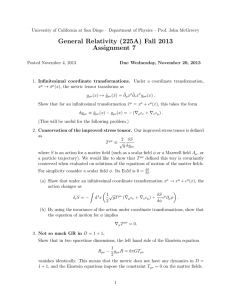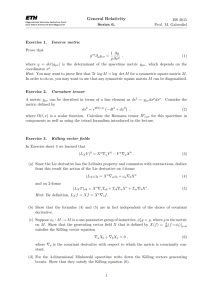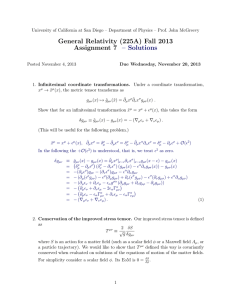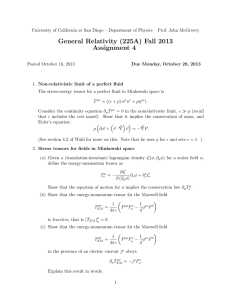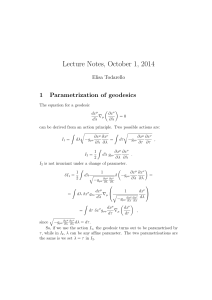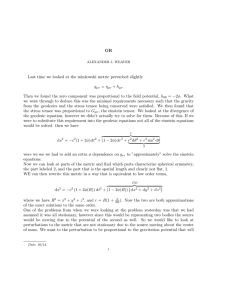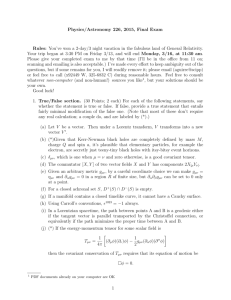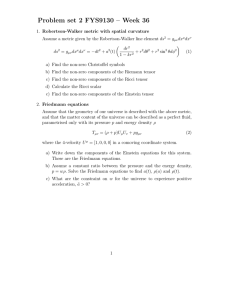Continuity Equations and the Energy
advertisement
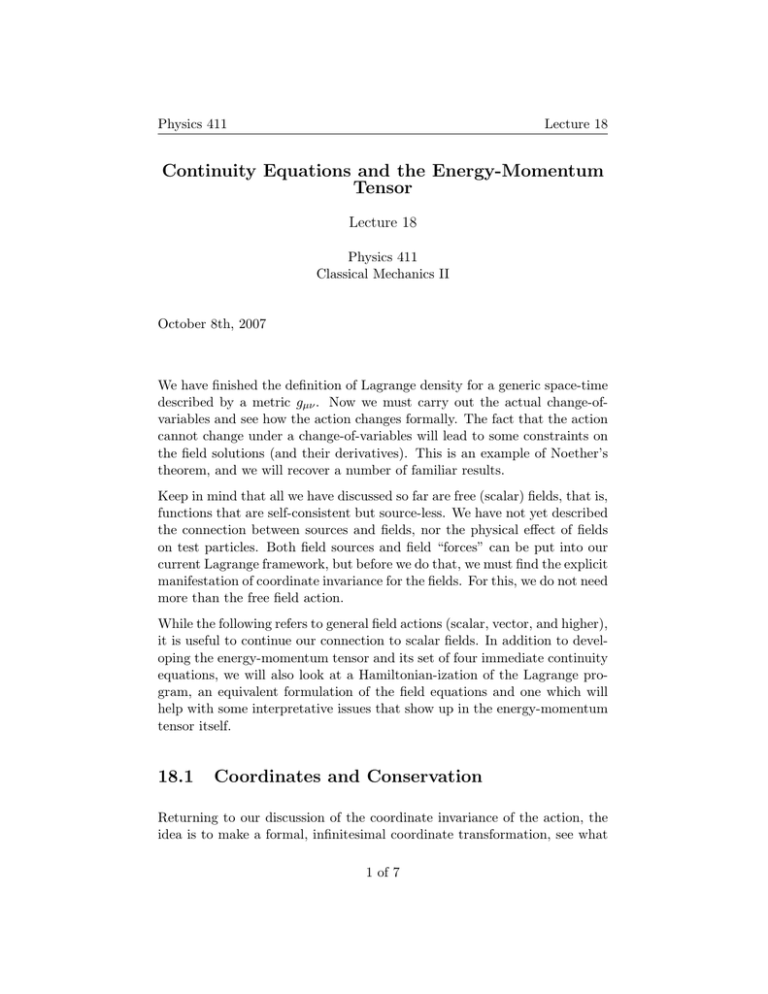
Physics 411
Lecture 18
Continuity Equations and the Energy-Momentum
Tensor
Lecture 18
Physics 411
Classical Mechanics II
October 8th, 2007
We have finished the definition of Lagrange density for a generic space-time
described by a metric gµν . Now we must carry out the actual change-ofvariables and see how the action changes formally. The fact that the action
cannot change under a change-of-variables will lead to some constraints on
the field solutions (and their derivatives). This is an example of Noether’s
theorem, and we will recover a number of familiar results.
Keep in mind that all we have discussed so far are free (scalar) fields, that is,
functions that are self-consistent but source-less. We have not yet described
the connection between sources and fields, nor the physical effect of fields
on test particles. Both field sources and field “forces” can be put into our
current Lagrange framework, but before we do that, we must find the explicit
manifestation of coordinate invariance for the fields. For this, we do not need
more than the free field action.
While the following refers to general field actions (scalar, vector, and higher),
it is useful to continue our connection to scalar fields. In addition to developing the energy-momentum tensor and its set of four immediate continuity
equations, we will also look at a Hamiltonian-ization of the Lagrange program, an equivalent formulation of the field equations and one which will
help with some interpretative issues that show up in the energy-momentum
tensor itself.
18.1
Coordinates and Conservation
Returning to our discussion of the coordinate invariance of the action, the
idea is to make a formal, infinitesimal coordinate transformation, see what
1 of 7
18.1. COORDINATES AND CONSERVATION
Lecture 18
changes (to first order) that induces in the action S → S + δS and require
that δS = 0, enforcing the overall isometric nature of S. We begin with the
action
Z
S = L(φ, φ,µ , gµν ) dτ
(18.1)
√
where L = −g L̄(φ, φ,µ ) is the Lagrange density, and we indicate the metric
dependence in L. Now we introduce an infinitesimal coordinate transformation:
x0µ = xµ + η µ
(18.2)
with η µ a small, but general perturbation η µ = η µ (x). The coordinate
transformation generates a perturbation to both the field φ(x) and the
0 (x0 ) =
metric gµν (x) – let’s write these as φ0 (x0 ) = φ(x) + δφ(x) and gµν
gµν (x) + δgµν (x). We can connect these explicitly to the perturbation η µ (x)
by Taylor expansion – take φ(x0 ):
φ0 (x0 ) = φ(x0 ) = φ(x + η) = φ(x) +
so we would call δφ =
0 (x0 ) in a moment.
gµν
∂φ
∂xµ
∂φ µ
η + O(η 2 )
∂xµ
(18.3)
η µ . We’ll return to the analagous procedure for
Viewing the Lagrange density as a function of φ, φ,µ and gµν we have
∂L
∂L
∂L
δφ+
δφ,µ +
δgµν ,
∂φ
∂φ,µ
∂gµν
(18.4)
and it is pretty clear what will happen to the action when we put this in
and integrate by parts – we’ll get:
Z Z
∂L
∂L
∂L
0
S [φ + δφ] = S[φ] +
− ∂µ
δφ dτ +
δgµν dτ . (18.5)
∂φ
∂φ,µ
∂gµν
|
{z
} |
{z
}
L(φ+δφ, φ,µ +δφ,µ , gµν +δgµν ) ≈ L(φ, φ,µ , gµν )+
=0
≡δS
Notice that the first perturbative term above vanishes by the field equations
– indeed, this first term is just the result of an induced variation of φ (the
field equation for φ comes from arbitrary variation, we are just picking a
particular variation δφ associated with coordinate transformations, so the
field equations still hold). The second term, labelled δS must be zero for S
to remain unchanged. Now we need to connect the change in the metric to
the change in coordinates. It is tempting to simply set ∂g∂Lµν = 0, but this
is overly restrictive (δgµν here refers to a specific type of variation for the
metric, not a generic one).
2 of 7
18.1. COORDINATES AND CONSERVATION
Lecture 18
Consider the general transformation of a second rank covariant tensor
0
gµν
(x0 ) =
∂xα ∂xβ
gαβ (x).
∂x0µ ∂x0ν
(18.6)
If we re-write the transformation in terms of the original variables (so that
we can recover S in its original form), then
0
gµν
(x) = gµν + −η β,ν gµβ − η α,µ gαν − gµν,σ η σ
(18.7)
with both sides functions of x now.
A moral point: we rarely (if ever) leave partial derivatives alone – a comma
(as in gµν,σ ) is, as we have learned, not a tensor operation. The whole point
of introducing covariant differentiation was to generate tensor character, so
it is always a good idea to use it. We are in luck, the metric’s covariant
derivative vanishes (by definition, effectively, but we saw this a while ago),
so that:
gµν;σ = gµν,σ − Γαµσ gαν − Γασν gµα = 0.
(18.8)
The partial derivative on η β,ν can also be replaced via
η β;ν = η β,ν + Γβσν η σ ,
(18.9)
and similarly for the η α,µ . Until, finally, we have
0
gµν
(x) = gµν − ηµ;ν − ην;µ .
(18.10)
Evidently, the perturbation is δgµν = −(ηµ;ν + ην;µ ) and we are, finally,
ready to return to δS.
Referring to (18.5), we can define a new density built from a tensor T µν
1√
∂L
−g T µν ≡ −
2
∂gµν
(18.11)
which is symmetric, so that
Z
Z
√
√
1
1
µν
δS = −
dτ −g T δgµν = +
dτ −g T µν (ηµ;ν + ην;µ )
2
2
Z
(18.12)
√
µν
= dτ −g T ηµ;ν .
We have used the symmetric property of T µν to simplify (notice how the
strange factor of 12 and the minus sign from (18.11) have played a role). Now
3 of 7
18.2. THE STRESS-ENERGY TENSOR
Lecture 18
we can break the above into a total derivative, which will turn into a surface
integral that vanishes (by assumption, on the boundary of the integration,
η µ goes away) and an additional term:
Z
Z
Z
√
√
√
µν
µν
dτ −g T ηµ;ν = dτ
−g T ηµ ;ν − dτ −g T µν;ν ηµ . (18.13)
|
{z
}
=0
For arbitrary ηµ (x), then, we have
T µν;ν = 0.
18.2
(18.14)
The Stress-Energy Tensor
Think of a four-divergence in Minkowski space – an expression of the form
Aµ;µ = 0 reduces to (in flat space, ; →, and we take Minkowski in its usual
Cartesian form)
1 ∂A0
∂A0
+ ∇ · A = 0 −→
= −v ∇ · A
v ∂t
∂t
(18.15)
with A the spatial components of the four-vector Aµ . This is a continuity statement – in generic language, we say that the zero component is
the conserved “charge”, and the vector portion the “current”, terms coming from one of the most common examples: charge conservation where
J µ =(c
˙ ρ, Jx , Jy , Jz ) = (c ρ, J), and then
∂ρ
= −∇ · J
∂t
(18.16)
(with v = c for E&M). The Lorentz gauge condition can also be expressed
this way, with Aµ =(φ/c,
˙
Ax , Ay , Az )T , leading to
1 ∂φ
= −∇ · A.
c2 ∂t
(18.17)
For a second rank tensor in this setting, the statement (18.14) becomes four
equations
1 ∂T 00 ∂T 0j
0=
+
j = 1,2,3
v ∂t
∂xj
(18.18)
1 ∂T j0 ∂T jk
0=
+
.
v ∂t
∂xk
4 of 7
18.2. THE STRESS-ENERGY TENSOR
Lecture 18
If we integrate over an arbitrary spatial volume, and use the usual form of
Gauss’s law, we can interpret these four equations as continuity equations
as well
Z
I
∂
1 00
T dτ = − T 0j daj
∂t
v
Z
I
(18.19)
∂
1 0j
jk
T dτ = − T dak ,
∂t
v
with the obvious identification of a scalar and three-vector in flat space.
In order to understand the actual physics of this T µν tensor, we will find
the explicit form in terms of the Lagrange density and see what this implies
about our scalar field.
18.2.1
The Tensor T µν in General
From its definition:
2
∂L
T µν = − √
,
−g ∂gµν
(18.20)
we need the derivative of the density L in terms of gµν . A typical density,
like our scalar field, will depend on gµν through g, the determinant, and
potentially, a metric that is used to contract terms like φ,µ g µν φ,ν . Let’s
assume the form is
√
L(φ, φ,µ , gµν ) = −g L̄(φ, φ,µ , gµν )
(18.21)
and note that
√
∂ −g
∂gµν
=
1
2
√
−g g µν , so
√
∂L
1√
∂ L̄
=
−g g µν L̄ + −g
.
∂gµν
2
∂gµν
(18.22)
The tensor of interest is
T
µν
∂ L̄
µν
= − g L̄ + 2
.
∂gµν
5 of 7
(18.23)
18.2. THE STRESS-ENERGY TENSOR
18.2.2
Lecture 18
Free Scalar Field (Minkowski)
For the free scalar field, the Lagrange scalar is L̄ = 21 φ,α g αβ φ,β . If we input
this Lagrange scalar in (18.23), we need to evaluate the term1
1
∂ L̄
= − φ,α φ,β g αµ g βν ,
∂gµν
2
(18.24)
and the T µν tensor is
T µν = φ,α φ,β g αµ g βν −
1 µν
g φ,α g αβ φ,β .
2
(18.25)
Again, we have the question of interpretation here – referring to our original
discrete Lagrangian, from whence all of this came, we can transform to a
Hamiltonian, and this will give us an expression (upon taking the continuum
limit) for what might reasonably be called the energy density of the field.
The procedure is motivated by its classical analogue – where the temporal
derivative is privileged – this seems strange in our current homogeneous
treatment, but lends itself to an obvious energetic interpretation.
In the particle case, the canonical momentum associated with the motion of
∂L
an individual portion of the string (for example) would be ∂ φ̇(x̄
= µ φ̇ = π
,t)
j
– suggesting that we take, as the canonical momentum for the field φ: ∂∂L̄φ̇ ≡
π. Starting from
1
1
1 2
µν
02
L̄ = φ,µ g φ,ν =
− 2 φ̇ + φ
(18.26)
2
2
v
we identify π = − v12 φ̇, and then
1
1
1
H̄ = φ̇ π − L̄ = − 2 φ̇2 − − 2 φ̇2 + φ02
v
2v
2
1 1 2
=−
φ̇ + φ02 ≡ −E,
2 v2
(18.27)
where we define the energy density E to be the negative of H̄ (this is just
a matter of the metric signature, nothing deep). Compare this with T 00
from (18.25) – that component is
1 1 2
1
00
2
2
02
T = φ,0 φ,0 +
−φ,0 + φ,1 =
φ̇ + φ
2
2 v2
(18.28)
= E,
1
Using
∂g αβ
∂gµν
= −g αµ g βν
6 of 7
18.2. THE STRESS-ENERGY TENSOR
Lecture 18
so that the zero-zero (pure temporal) component of T µν is naturally identified with the energy density of the system.
If we introduce our overall factor (multiply by µ v 2 in L̄) to make contact
with real longitudinal oscillations, then the energy density is (with units)
E=
1
1
µ φ̇2 + µ v 2 φ02
2
2
(18.29)
which is pretty clearly the kinetic and potential energy per unit length (think
of what we would have gotten out of the Hamiltonian for balls and springs).
Now we want to find the natural momentum density here, Rand we can work
b
directly from the energy for a short segment of string E = a E dx – as time
goes on, energy will flow into and out of this segment, and we can calculate
the temporal dependence of that flow via:
Z 1
1
dE
E(t + dt) = E(t) +
dt =
µ (φ̇(t + dt))2 + µ v 2 (φ0 (t + dt))2 dx
dt
2
2
Z 1
1
2
2 0
2
2 0 0
=
µ φ̇(t) + µ v φ (t) + dt µ φ̈ φ̇ + µ v φ φ̇
dx,
2
2
(18.30)
and using the field equation: φ̈ = v 2 φ00 , we can write the derivative as:
Z
dE
∂ 2
(18.31)
=
µ v φ̇ φ0 dx
dt
∂x
which, as a total derivative, can be evaluated at the endpoints as usual. In
terms of the local statement, we have:
∂E
∂ =−
−µ v 2 φ̇ φ0 .
∂t
∂x
(18.32)
This is supposed to be related to the T 0x element of the stress tensor – we
expect, from (18.18), that: T 0x = µ v φ̇ φ0 – but that is precisely what we
get from (18.25). In addition, we can interpret this component in terms of
momentum density – for a patch of field between x and x + dx, we have
mass displaced from x into the interval: φ(x), and mass displaced out of the
interval on the right: φ(x + dx) – then the momentum in this interval is
pdx = µ φ̇ (φ(x) − φ(x + dx)) dx ∼ µ φ̇ φ0 dx
and this is related to T 0x by one factor of v: p =
7 of 7
1
v
T 0x .
(18.33)
